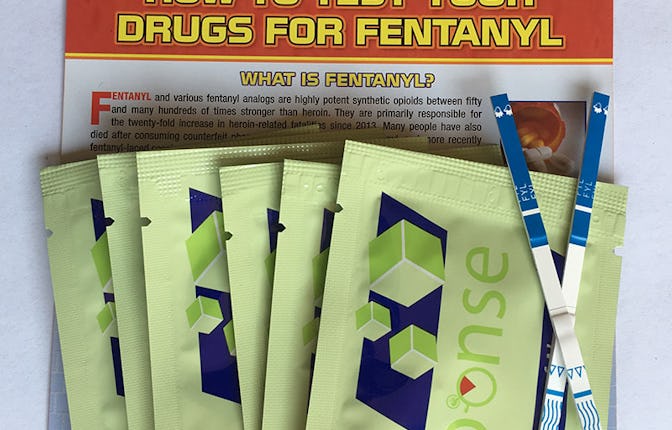How to test your drugs
A guide to getting high off of only what you mean to.

It wasn’t too long after bars and clubs came roaring back to life in New York City over the summer that many of my friends began to share cryptic posts warning about fentanyl, an extremely potent synthetic opioid that is quickly becoming ubiquitous. It seemed like every other weekend, some party going friend-of-a-friend was dropping dead after they took something that was unknowingly laced.
Over the past year, a record 100,000 Americans died of drug overdoses and out of those deaths, a staggering 64,158 were involved fentanyl. Although many people are taking the drug directly, many others are dying after taking it unwittingly — whether from a source that sold them bootleg prescription meds, or dealers who are mixing it into recreational drugs such as cocaine, ketamine, or MDMA.
Fentanyl is versatile enough to be mixed into powders, pressed pills, and capsules. The drug was originally created to reduce pain in cancer patients and causes feelings of relaxation and euphoria; for that reason, it is sometimes mixed with street drugs to increase their potency, according to the Drug Enforcement Administration.
The problem is that when people are mixing fentanyl with something else, the fentanyl is not always evenly distributed and some batches could contain lethal levels of the opioid while others contain none at all. So just because your friend has used a certain dealer and was completely fine doesn’t mean that you’re going to have the same experience.
“All street drugs have the potential of being cut, purposely or accidentally, with fentanyl or fentanyl analogs,” Arwen Podesta, a New Orleans-based psychiatrist who specializes in addiction recovery (and author of Hooked), tells me.
The only way to really be safe is to start incorporating testing as a routine part of your drug consumption habits. Whenever you plan to buy, make sure that you’re carrying Fentanyl Test Strips (FTS) with you. Their availability varies by state — in larger cities, they’re often found at syringe exchanges or harm reduction centers. If you’re in a more rural place, familiarize yourself with local organizations that might carry them or you can even buy them online.
Once you have the strips, dissolve all the drugs you plan to use in a glass of water before dipping a test strip inside. Again, fentanyl could be unevenly distributed in what you’re about to take, so testing everything you plan to put in your body is your safest bet, according to the New York City Department of Health. If a test comes out negative, you can drink the water containing the drug, snort it with a nasal spray or wait for the water to evaporate, per the Department of Health. Other alternatives include crushing the drugs into powder form in a Ziploc bag, taking out the powder and filling the bag with water. Residues of the drug left in the bag should be enough for a test strip to pick up whether there is fentanyl present.
Even if you start testing every time, though, it’s good to prepare for the possibility of an actual overdose. Naloxone, commonly known by the brand name Narcan, is an injection or nasal spray that reverses an overdose and is available at several pharmacies, including CVS. They can fit easily into a small bag so you can carry that on your nights out, too.
While the idea of stepping in when someone is overdosing can be daunting, especially if you avoid medical dramas and are queasy like me, there are some pretty comprehensive videos online that show you what to do and will make it less scary if you are ever in a situation like this. While you’re at it, familiarize yourself with early signs of overdoses, including drowsiness, blue or purple lips, nausea, and shallow breathing.
Although fentanyl is a spooky new frontier in the opioid epidemic, we can take measures to keep ourselves and each other safe. Look, I won’t judge if you want to snort and bump n’ thump all night — that’s between you and your god — but please, start making testing strips and Narcan a part of your going out routine.